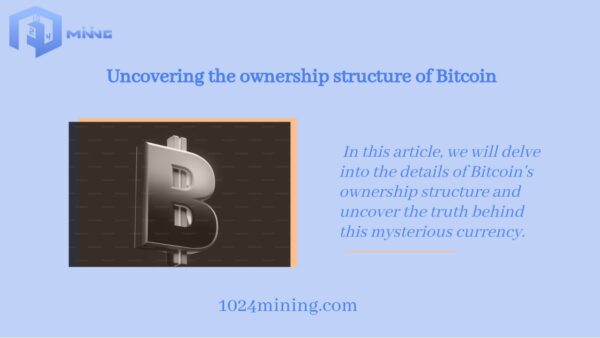Bitcoin, the world’s first decentralized digital currency, has been making waves in the financial world since its inception in 2009. With its increasing popularity and value, many people are curious about the ownership structure of this cryptocurrency. In this article, we will delve into the details of Bitcoin’s ownership structure and uncover the truth behind this mysterious currency.
Ownership Structure
One of the most intriguing aspects of Bitcoin is its ownership structure. Unlike traditional currencies, there is no central authority or institution that controls Bitcoin. Instead, it is owned and controlled by its users. This means that anyone can own Bitcoin, and the ownership is spread out among a large number of individuals and organizations.
Satoshi Nakamoto
The creator of Bitcoin, known as Satoshi Nakamoto, is the largest known holder of Bitcoin. However, their true identity remains a mystery, and it is estimated that they own around 1 million Bitcoins, which is equivalent to over $10 billion at the current market value. It is believed that Satoshi Nakamoto has not touched their Bitcoin since the early days of its creation.
Early Adopters
In the early days of Bitcoin, when it was still relatively unknown, a small group of individuals known as “early adopters” were able to mine large amounts of Bitcoin with little competition. These early adopters are estimated to hold a significant portion of the total Bitcoin supply.
Exchanges and Investment Funds
As Bitcoin gained popularity and value, many exchanges and investment funds were created to facilitate the buying and selling of Bitcoin. These entities hold a large amount of Bitcoin on behalf of their clients, making them significant holders of the cryptocurrency.
Individual Users
The vast majority of Bitcoin holders are small investors, and as of November 2023, approximately 74% of Bitcoin addresses held less than 0.01 BTC.The majority of Bitcoin ownership is held by individual users who have purchased or mined the currency. These users range from casual investors to large-scale miners who have invested significant resources into acquiring Bitcoin.
Conclusion
In conclusion, the ownership structure of Bitcoin is decentralized and spread out among a large number of individuals and organizations. While the true identity of the creator remains a mystery, it is estimated that early adopters and exchanges hold a significant portion of the total Bitcoin supply. As Bitcoin continues to gain popularity and value, its ownership structure is likely to become even more diverse and widespread.
Bitcoin ownership is dispersed and diverse. Bitcoin owned by reputable institutions demonstrates the maturity of the Bitcoin market and its growing public acceptance and mainstream adoption. Going forward, global political and regulatory developments are likely to have a significant impact on the asset’s continued adoption and demand. For example: The possible emergence of a spot Bitcoin ETF in the United States could further remove friction for individuals and institutions seeking allocations to Bitcoin, while Argentina’s recent presidential election could signal a shift in how developing economies view Bitcoin and other cryptoassets.
Have you invested in Bitcoin? What do you think about its ownership structure? Let us know in the comments.



